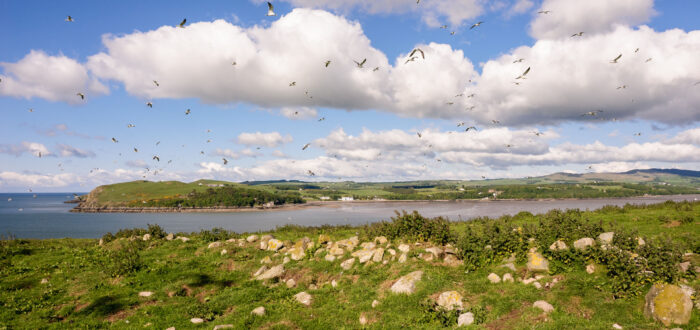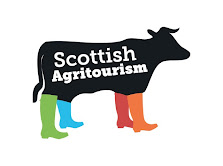What are those birds we can see from the window? At Destination Balcary guests often look out of the conservatory window and see a huge variety of birds and gulls soaring above the fields or feeding on the farmland and wonder what they actually are? Many of us label all seabirds generically as seagulls (well I do, through pure ignorance), but there are many different varieties, so, what are they?
The Solway is one of the most important estuaries for birdlife and migratory birds in Britain holding up to 40,000 wildfowl and 83,000 waders during the winter period. Each season brings different and fascinating visitors to our shores.
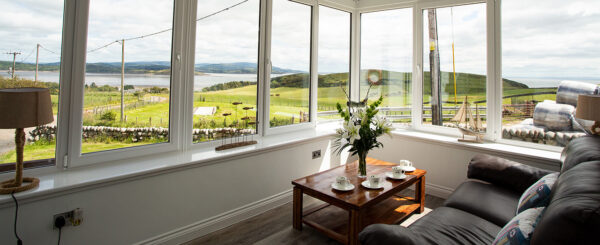
Views from the Conservatory at Destination Balcary
Biodiversity at Airds of Balcary – ‘Destination Balcary’
Here at Airds of Balcary Farm, we strive to enable sustainable farming which benefits the farm animals, wildlife, birdlife, the local environment, landscape and nature, making our spectacular peninsular beautiful for all to enjoy. We have 494 acres of permanent grassland, woodland, pond, reseed, rough grazing and many wildflower areas, which attracts a huge variety of wildlife right on our doostep and the coastline along the Balcary peninsula.
Views From The Farmhouse
Destination Balcary has a wonderful 180 degree view conservatory with a large picture window looking out across the farmland over the Galloway hills and across the Solway Firth to the Lake District beyond. It is a superb viewpoint and very warm and cosy birdhide!
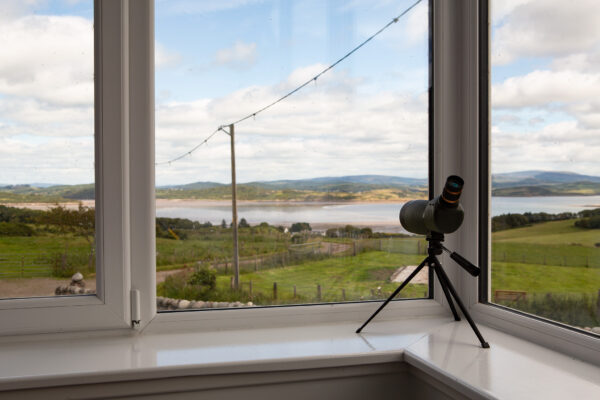
Check out the wildlife and views using the telescope & tripod through the conservatory windows
There is a useful telescope on a tripod in the conservatory that allows guests to enjoy the views, birdlife and wildlife in more detail. However many of the birds can be seen easily without any telescopic aid.
Local Birdlife at Destination Balcary
The most likely birdlife to be seen from the conservatory at Destination Balcary are:
- Fulmar – grey and white seabirds similar to gulls with tube noses and related to the albatross
- Kittiwake – A gentle looking, medium-sized gull with a small yellow bill and a dark eye. It is a common and widespread breeding bird in Scotland. It has a grey back and is white underneath.
- Herring Gull – Large gull with a somewhat large, but slim bill and robust body. Breeding adults have clean white heads and underparts with pale grey backs and wings
- Gulls – Often known as seagulls (though no species is actually called a seagull), often get a bad reputation for stealing chips. Gulls are intelligent, adaptable and often beautiful birds.
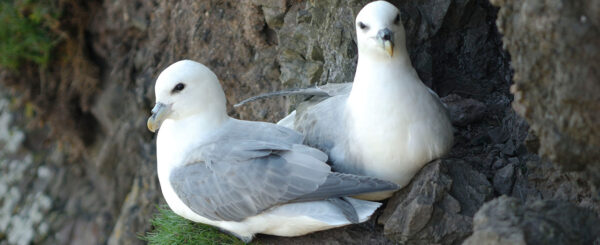
Fulmar pair on cliff Balcary
- Shearwaters – Are drab, slender-billed birds medium-sized long-winged seabirds commonly found following fishing vessels for scraps
- Raven – The common raven is a big black bird, a member of the crow family. It is massive, bigger than a buzzard. It is all black with a large bill, and long wings.
- Rooks & Crows – Rooks are usually in flocks. Rooks nest in colonies where crows nest with one pair in a tree. If there’s more than one crow they are rooks, if there is only one rook it is a crow!
- Rock Pipit – The rock pipit is a large stocky pipit, larger than a meadow pipit & smaller than a starling. It breeds around coasts where there are rocky beaches.
- Linnet – A small and slim finch that’s widespread and was once very popular as a caged bird because of its melodious song. Males are marked with crimson foreheads
- Stonechat – A small, dumpy chat, the stonechat is a little smaller than a robin. It has a big head and short tail. It can frequently be seen sitting on the top of gorse
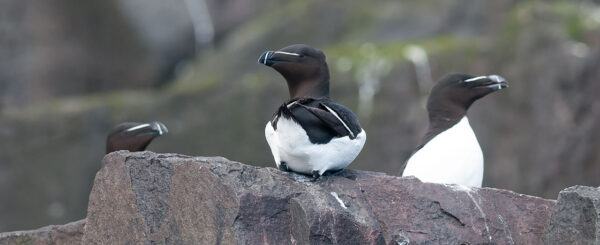
Razorbills – Credit Keith
Coastal Birdlife & Wildfowl
In addition to the above, if you walk down to the coastal path you are likely to see
- Cormorant – a large, black waterbird whose size and colour make it very visible. With a reptilian neck, it has an almost prehistoric appearance.
- Guillemot – Chocolate-brown above and white below. They are among the deepest diving birds in the world, typically diving beyond 30m
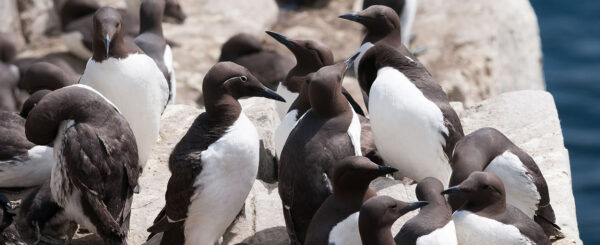
Guillemots – Credit Keith
- Razorbill – Black head and back with white underside medium sized seabird. It has a thick black beak which is deep and blunt. Another diving bird.
- Oystercatcher – A large, stocky, black and white wading bird. It has a long, orange-red bill and reddish-pink legs
- Shags – Dark, goose-sized birds with long necks. They look similar to Cormorants but are smaller and slimmer with a characteristic steep forehead
- Gannets – Gannets are large and bright white with black wingtips. They are distinctively shaped – with a long neck and long pointed beak, long pointed tail
- Arctic Skua – Is a large seabird. Arctic skuas are fierce pirates of sea, renowned for stealing fish from other seabirds and dive-bombing anyone that comes near its nests.
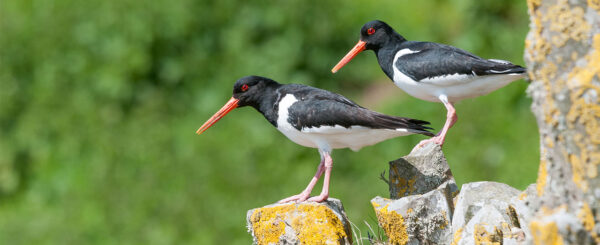
Oystercatchers – Credit Keith
Where Can I Go To See More Birdlife Locally
The local ‘Balcary Bay and Rascarrel walk’ is a great start as it takes you along the stunning coastal past Balcary Point, along the Balcary Heughs (steep bank or cliff overhanging the sea) and a haven and home for many seabirds and birdlife.
Balcary Heughs
Habitats: Coastal cliffs, Farmland, Woodland, Scrub & Freshwater Loch.
Birds that can be spotted: Fulmar, Cormorant, Guillemot, Razorbill, Kittiwake, Rock Pipit, Linnet, Stonechat.
Facilities: The car park at road end has an information board with map of the local area and walking route.
Access: There is a lovely circular walk that includes Loch Mackie and Rascarrel Bay. Take care as there are steep cliffs which are host to many seabirds.
A short drive will also take you several other areas and depending upon time of the year it can be teeming with migrating birds along with those indigenous species who have made it their home.
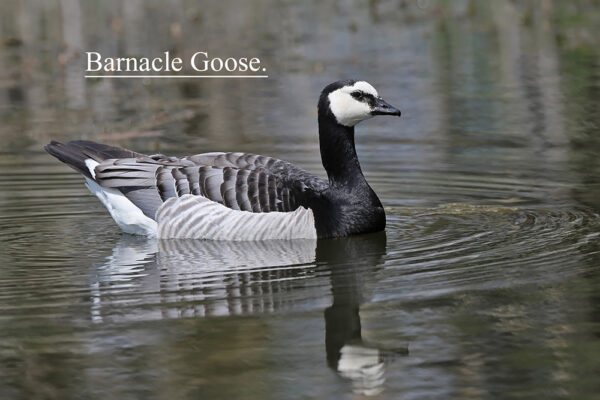
Barnacle Goose
The Inner Solway Region
The Solway flats and marshes are internationally important for ten species of overwintering waterfowl (Whooper Swan, Pinkfooted Goose, Barnacle Goose, Pintail, Scaup, Oystercatcher, Knot, Bar-tailed Godwit, Curlew and Redshank) and nationally important for a further nine species (Great Crested Grebe, Cormorant, Shelduck, Teal, Common Scoter, Ringed Plover, Golden Plover, Grey Plover and Sanderling).
The inner Solway area is the best places to see Barnacle Goose, Whooper Swan, Bar-tailed Godwit, Knot, Purple Sandpiper, Sanderling and Skuas.
View this post on Instagram
Mersehead RSPB Reserve
Maybe a chance to see birds of prey including the Hen Harrier and Merlin (a smaller version of the falcon).
Habitats: Wetland, saltmarsh, sand dunes, sandflats and arable rotation / grassland.
Birds: Internationally important for over wintering Svalbard Barnacle Geese, Pintail and Teal. Other wildfowl include Pink-footed Geese, Whooper Swan, Wigeon, Shoveler and Shelduck. Peregrine, Hen Harrier and Merlin. Passage/wintering waders and finch flocks.
Good numbers of breeding wetland waders and Skylark. Reed Warbler and Water Rail have colonised. Seabirds and sea-duck can be seen offshore.
Facilities: Visitor Centre, two hides, wetland and coastal trails. Sulwath Centre (education/training/ volunteering).

Golden plover
Southerness Beach
Great to go over the winter time to see the migratory waders and speckled grey or golden plover.
Habitats: Sand and mudflats, rocky shore, maritime heath and sand dunes.
Birds: One of the best places on the Solway to see over wintering waders, especially flocks of Knot, Dunlin, Bartailed Godwit, Grey Plover, Golden Plover, Oystercatcher. The Purple Sandpipers, divers, grebes, auks, scoters and other sea ducks are best seen opposite the Southerness Lighthouse.
Facilities: Parking and toilets in Southerness village
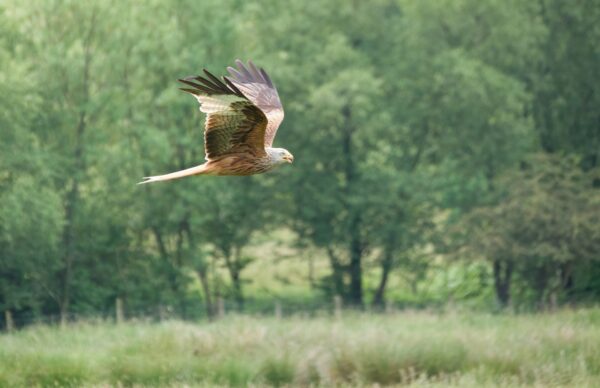
Red Kite in Flight – Credit Stephen Cooper
Red Kites & Birds of Prey
A favourite with many guests if to head up to Galloway Kite Trail around Loch Ken and the Red Kite feeding station at Bellymack Hill Farm. A good time to go and see these graceful birds of prey soaring on the thermals is around feeding time at 2.00pm.
Local Guide to Birdwatching Sites
Across Dumfries and Galloway there are many other inland locations, habitats and RSPB reserves to find wonderful wildlife, wildfowl and ideal birdwatching sites throughout the seasons.
This following downloadable PDF booklet created by The Scottish Ornithologists’ Club (SOC) gives an introduction to the best and most easily accessible birdwatching sites in and around Dumfries and Galloway. It also provides a very good guide and resource on where to and what you will see.
Useful Links
- Biodiversity at Destination Balcary – https://destinationbalcary.com/about/biodiversity/
- 7 Great Places to see Nature & Wildlife in Dumfries and Galloway – https://destinationbalcary.com/2023/08/7-great-places-to-see-nature-wildlife-in-dumfries-and-galloway/
- What Guests Love about Destination Balcary – https://destinationbalcary.com/2023/09/what-guests-love-about-destination-balcary/
- Birdwatching in Dumfries & Galloway – https://www.the-soc.org.uk/pages/dumfries-birdwatching-sites
- Birds of Dumfries & Galloway PDF Booklet – https://swseic.org.uk/what-to-see/dumfries-galloway/species/birds/
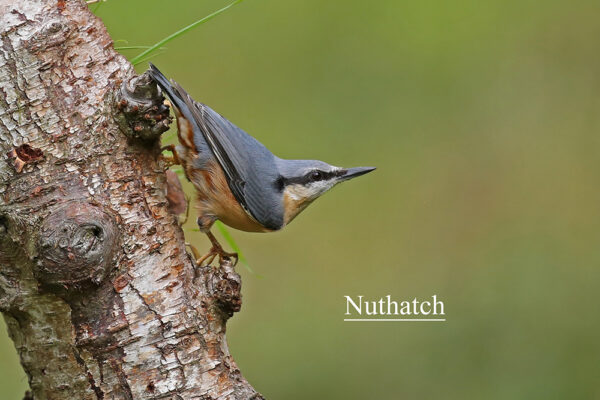
Nuthatches Smart wee bird known for its habit of working its way down tree trunks rather than work upwards. Great characters.

